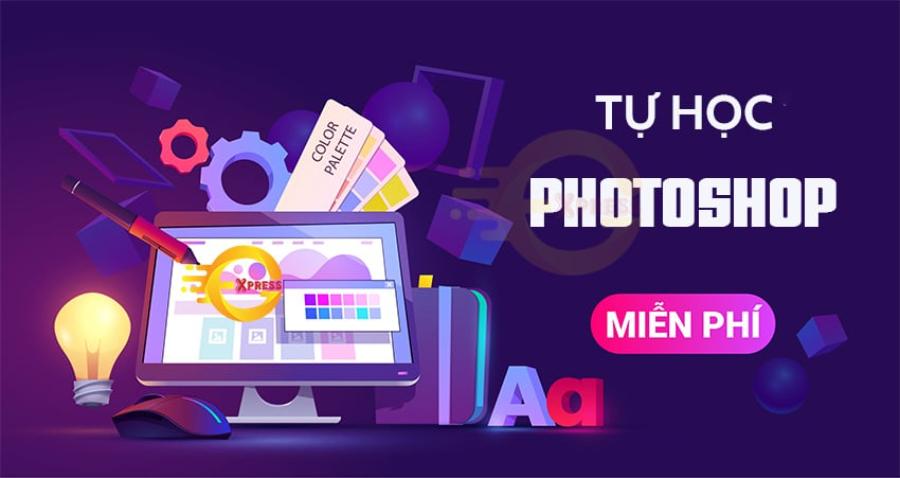Best Selling Products
7 Things to Know When Starting to Learn Photoshop for Beginners
Nội dung
- 1. Get Familiar With the Interface and Basic Tools
- 2. Understanding Layers and Their Importance
- 3. Use Selection Tools Effectively
- 4. Understanding Color Editing Tools
- 5. Working With Text and Typography Tools
- 6. Create Blur and Sharpen Effects on Photos
- 7. Always Save and Manage Image Files Properly
- 8. Conclusion
Discover 7 important tips to help beginners learn Photoshop easily. Learn basic tips to use Photoshop effectively for photo editing and graphic design.

1. Get Familiar With the Interface and Basic Tools
Photoshop has a complex interface with a variety of tools and panels. Therefore, the first step in learning Photoshop is to familiarize yourself with the user interface. You will see toolbars on the left, control panels on the top, and adjustment panels on the right (Layers, Adjustments, Properties, etc.). Understanding how to arrange and use these tools will save you time and effort when editing photos.
(1).jpg)
To get familiar with the interface, you can start with a few basic tools like Move Tool , Brush Tool , Lasso Tool , Eraser Tool and Text Tool . These are the tools that are frequently used in simple image editing projects, helping you master Photoshop quickly.
Also, get familiar with layer management to easily edit and organize elements in your designs. Don’t forget to take advantage of online learning resources such as video tutorials, forums, and official Adobe documentation to improve your skills. With persistence and regular practice, you will quickly master Photoshop and create high-quality products.
2. Understanding Layers and Their Importance
Layers are one of the most important elements in Photoshop. Layers act as transparent layers that are stacked on top of each other to create a complete design. Each layer can contain a part of an image, text, or an effect. Understanding layers makes it easier to make edits without changing the entire image. This also gives you more flexibility to experiment with effects without worrying about losing data.
You should know how to create new layers, hide or show layers, manipulate layers through the Layer Panel, and use layer masks to create fading effects or cut out unnecessary parts. When you are proficient with layers, you will be able to edit photos in a more professional and easier way.
.jpg)
The importance of layers lies in their ability to help you stay organized, easily edit each part separately without affecting the other parts. Understanding how to use layers will save you time, increase your work efficiency, and open up more creative opportunities in your designs. So take the time to familiarize yourself and practice with this tool, because it is a solid foundation for any Photoshop project.
3. Use Selection Tools Effectively
Selection tools such as the Marquee Tool, Lasso Tool, and Quick Selection Tool help you select areas of your photo that need to be edited. Using selection tools correctly will help you work faster and more accurately when working with photos. To use them effectively, you should learn about tools such as the Marquee Tool, Lasso Tool, Magic Wand, and Quick Selection Tool. At the same time, combining shortcuts and features such as Feather or Refine Edge will help you create softer and more natural selections.
.jpg)
For example, you can use the Quick Selection Tool to quickly select areas to change or the Lasso Tool to select a more complex area. Once you've selected an area, you can change the color, smooth the image, or perform other operations without affecting the rest of the image.
Be patient and practice and experiment with these tools to improve your skills, as they are the basic and necessary foundation for any design project on Photoshop.
4. Understanding Color Editing Tools
When you first start learning Photoshop, mastering the color editing tools is an important factor in improving your design and image editing skills. First, you need to understand how to use basic tools such as Hue/Saturation, Color Balance, and Levels to adjust the overall color of your photo. Additionally, familiarizing yourself with the Curves tool will give you more detailed control over brightness and contrast.
Understanding how to use these tools will allow you to create beautiful, color-accurate photos. You should also experiment with Adjustment Layers to change the color without changing the original image, making it easier to adjust later.
.jpg)
Take the time to play around with each tool to understand how it works and how it affects your image. Don’t forget to use Adjustment Layers for non-destructive editing, which will allow you to easily go back to previous steps when needed. A solid understanding of these tools will be a solid foundation for your professional design skills in the future.
5. Working With Text and Typography Tools
When learning Photoshop, working with the Text and Typography tools is an important skill that will help you create impressive and professional designs. Photoshop provides powerful tools that allow you to create text directly on your photos or graphic designs, while giving you full control over the typeface, size, color, and position.
To use these tools effectively, you first need to familiarize yourself with the Text Tool , where you can enter text, change fonts, and align text appropriately. When choosing a font, consider aesthetics and readability carefully, as fonts not only make an impression but also convey a design message.
In addition to choosing the right font, you should also familiarize yourself with Layer Styles effects such as Drop Shadow , Stroke , Outer Glow to highlight text and create depth for the design. Tracking , Kerning and Leading adjustment tools will help you control the spacing between characters, thereby creating more readable and balanced text. In addition, using Smart Objects will help you change the size of text without losing quality, especially useful when you work with large designs.
6. Create Blur and Sharpen Effects on Photos
When learning Photoshop, using the Blur and Sharpen effects is an important skill that helps you improve the quality of your images and create unique effects. Blur is used to blur unimportant areas in the photo, helping to highlight the main subject. Popular blur tools in Photoshop such as Gaussian Blur and Motion Blur allow you to flexibly adjust the level of blur, thereby creating a moving effect or softening details in the photo. In addition, using Lens Blur can create a bokeh effect, making the out-of-focus parts look smoother and more artistic.
.jpg)
On the other hand, when you want to sharpen an image, Photoshop provides tools like Unsharp Mask and Smart Sharpen to increase the clarity and detail of the image. These tools help to highlight small details like hair, surface textures or edges, making the photo look clearer and sharper. However, you need to be careful not to overuse these effects as they can make the photo noisy or unnatural.
Effectively combining Blur and Sharpen is an important part of photo editing, helping to create photos with depth and high aesthetics.
7. Always Save and Manage Image Files Properly
One of the important things to keep in mind when learning Photoshop is to get into the habit of saving and managing your image files properly . Photoshop works with large files that contain many layers, so saving regularly is essential to avoid losing data in the event of a problem.
First, you should save your files as PSD files while you work. The PSD format will retain all your layers, effects, and edits, making it easy to come back to edits later without losing any data. Don't forget to use the Auto Save feature in Photoshop to automatically save your work after a certain period of time, minimizing the risk of losing your work because you forgot to save.
Once you're done, you can export your images to other formats like JPEG , PNG , or TIFF , depending on what you're using them for. For example, if you want to upload your images to the web, JPEG is a good choice because it balances quality and size. If you need to keep the image quality high, for example for printing, TIFF is ideal because it saves images uncompressed. When saving your images, pay attention to choosing the right color mode . RGB mode is a good choice for digital images, while CMYK is necessary when working with printed publications.
Finally, it is also important to organize your project files properly on your computer. Creating folders and categorizing them by project makes it easy to access and manage your saved files without getting lost in a pile of documents. This will save you time and avoid data loss during long-term work with Photoshop.
Buy Cheap Photoshop License
8. Conclusion
Learning Photoshop can be a difficult process, but if you master the above notes and practice regularly, you will quickly improve your skills and be able to create beautiful, professional photos. Photoshop is not only a photo editing software but also a powerful tool for those who want to explore the world of graphic design. Don't forget to visit the website sadesign.vn to explore the tools here.












































